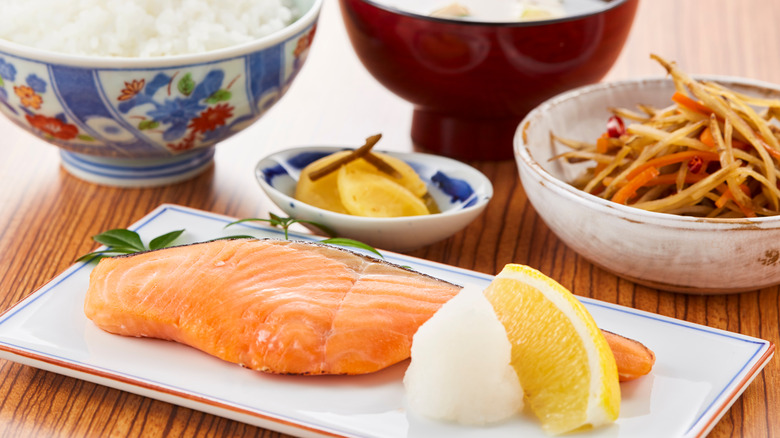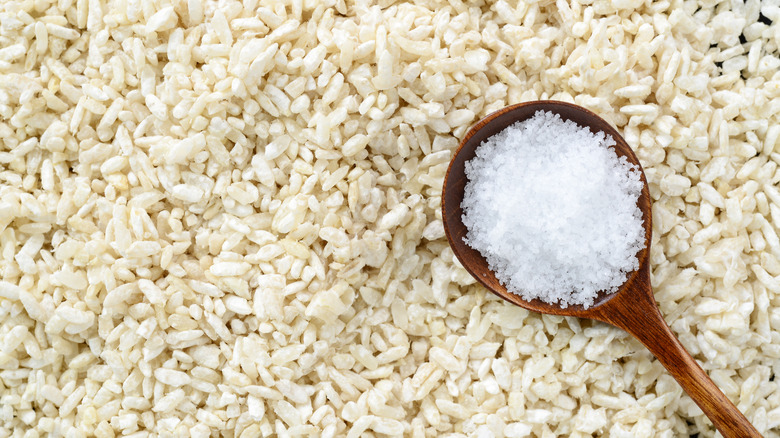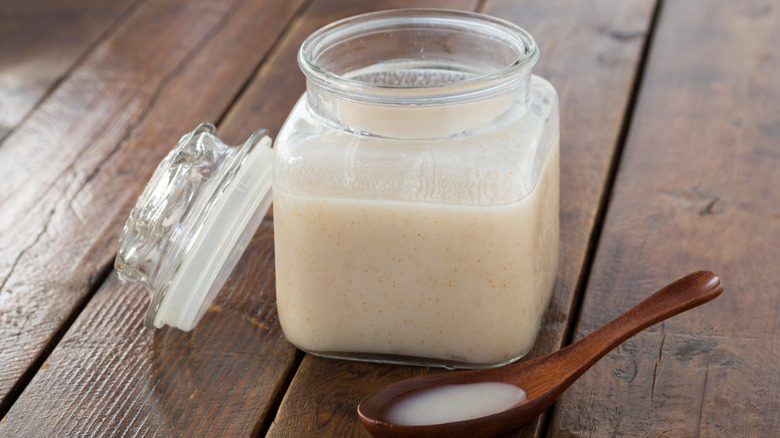Koji Salt Is The Ancient Secret To Fermented Foods
Fermentation was making a comeback in western markets in the late 2010s, according to Food Navigator, but the COVID-19 pandemic saw fermented foods firmly thrust into the mainstream. Amelia Nielson-Stowell, an editor at The Fermentation Association, told IFT, "Health-conscious consumers are flocking to fermented foods because of the health impact. There's a widespread acknowledgment that ... microorganisms can boost your gut microbiota and your immune system." The typical fermentation projects that people began in lockdown — sauerkraut, kimchi, sourdough, yogurt, and kombucha — all take advantage of a process called lacto-fermentation, per WIRED. However, there is another ancient fermentation technique that has been practiced in Asia for thousands of years to produce soy sauce, miso, and other deliciousness. It relies on a particular type of mold, Aspergillus oryzae, better known in East Asian culture as koji (via Epicurious).
The first written mention of koji (known to the Ancient Chinese as qu), appeared in "Rites of the Zhou Dynasty," published around 2300 years ago, according to Nordic Food Lab. Koji is a furry-looking mold that is made up of millions of tiny filaments that grow on the surface of grains that are inoculated with it. It looks quite similar to the kinds of mold you might see growing on old bread or citrus fruits, but thanks to centuries of refinement by ancient fermenters, it doesn't produce toxins like most species of Aspergillus. What it does produce, as explained by fermentation, are enzymes. These break down food and unlock hidden, unique flavors.
What is koji salt?
Shio Koji, also known as koji salt, is a superfast, easy-to-use version of koji, according to Revolution Fermentation. Koji fermentation can produce the deep, complex flavor bombs that are miso and soy sauce, but that process takes months or even years to completely ferment — koji salt takes about a week.
Per Serious Eats, the most common use for koji salt is as a marinade for proteins like chicken, fish, or beef. One of the enzymes koji produces is protease, which breaks down complicated proteins into delicious little amino acids, which gives foods an umami-rich flavor. Amino acids are also the starting point for the Maillard reaction, which is how you get a rich caramel-colored crust on steaks and grilled fish, as explained by Science of Cooking. As the name suggests, koji salt also contains plenty of salt, so you're going to be getting a lot of the flavor and texture benefits of brining your food when using this ingredient as a marinade.
As SushiSushi pointed out, shio koji isn't just a marinade for meats. You can also make Japanese-style pickled cucumbers or eggs by soaking them in koji salt. You can also take advantage of the subtly sweet, salty, and floral flavor by using it as a savory booster to things like soups and stocks, as advised by Kawashimaya.
Can you make koji salt at home?
Growing your own koji from scratch is a labor-intensive process that takes several days and the ability to guarantee a stable temperature of 90 to 95 degrees Fahrenheit for the first day, then 6-hourly cycles between 100 and 104 degrees for another day at least, according to Science Meets Food. Even with all of that effort, you'd still have to buy the koji spores to begin the whole process, so for simplicity's sake it's easiest to buy rice koji premade, per Plant-Based Matters.
Once you have gotten your hands on some deliberately moldy rice, the next steps to creating shio koji are just to mix the koji rice with water and salt, and keep it in a warm spot for 7 to 10 days before using, according to Cultures for Health. Funky Asian Kitchen recommended massaging the salt and water into the rice koji to promote fermentation, and stirring the mixture every few days as well, both of which are sensible ideas but aren't strictly necessary. Koji salt will keep for 3 months in the refrigerator.


